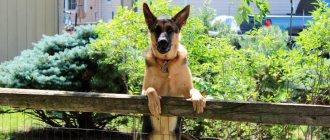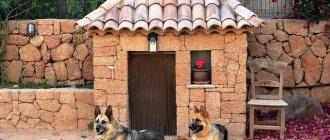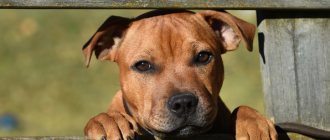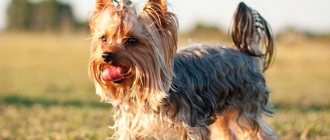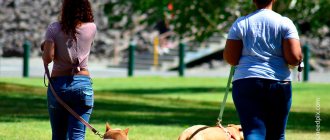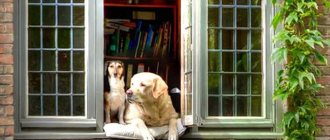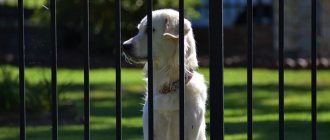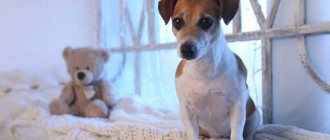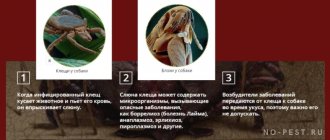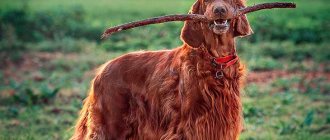When choosing a four-legged pet, many owners are guided not only by their easy-going disposition and appearance, but also by the presence of a guarding instinct. With such requirements, it is very important to take into account the object of protection. Even small four-legged animals can protect property and territory, since their main task is to warn about encroachment on private property. If the goal lies in mandatory punishment of the attacker, then you should pay attention to the best guard dog breeds that specialize in lightning-fast attacks on people and other animals.
The best dog breeds for apartment security
Spacious apartments with large living areas can accommodate even giant pets that do not suffer from hyperactivity. In more modest conditions, it is recommended to pay attention to medium-sized breeds. In addition to size, obedience, tolerance of children, and good socialization are important for pets living side by side with humans.
German Shepherd
The German Shepherd is not only the most recognizable, but also one of the smartest dogs. She gets along well with children and cannot stand being alone. Due to their innate protective instinct, these four-legged animals are wary of strangers, but never show open aggression.
Thanks to their developed intelligence, shepherd dogs quickly learn new skills. Despite this, they only reach psychological maturity by the age of 3 and are in great need of human care.
Rottweiler
Rottweilers are natural protectors. They see enemies even in neighboring children, so when raising them, they place special emphasis on early socialization.
Small Rottweilers cannot concentrate for long periods of time. They are constantly distracted by external stimuli, so classes should be frequent but short.
Doberman
Aristocratic Dobermans are always alert and selflessly devoted to their owner. They cannot be intimidated or appeased. In addition to security work, these four-legged animals are used for police service.
Dobermans love to learn. They absorb new information with great pleasure, so training them is a pleasure.
Cane Corso
The stern appearance of this dog often frightens passers-by, but in fact, a well-mannered Cane Corso is a kind and very playful creature that adores its owner. Only real attackers should be afraid of it, since the animal attacks such people without warning.
Complaisant and loyal pets are not inclined to dominate. They quickly recognize the authority of their owner, which makes them easier to train.
Medium dogs
Medium-sized dogs have all the necessary qualities for protection - a strong grip, distrust of strangers, good hearing and scent. Among other things, medium-sized guards are strong, resilient, and have a high level of activity, something that the giant prototypes lack.
German Shepherd
The German Shepherd is a universal assistant, used both in the army and police, and as a companion. German Shepherds are smart, obedient, animals.
Character – balanced, without unnecessary aggression. Despite the established image, the German Shepherd is not suitable for guard duty, because... The peculiarity of the breed is strict obedience, strict execution of the owner’s commands; without an order, the dog does not make decisions on its own.
To perform guard duty, a German Shepherd needs a companion - either a person who will give an action command, or another dog who will not allow the “German” to lose vigilance.
Boxer
The German Boxer is a dog with the character of a teenager, which remains throughout the pet's life.
The Boxer is suitable for keeping in an apartment or private house, but must live inside - short hair does not protect against the cold.
The pet's character is cheerful, stubborn, the Boxer is self-confident, and overly active. A representative of the breed is suitable for people leading an energetic lifestyle, ready for long walks and constant training sessions.
The German Boxer is an intelligent dog who, with proper training, will become a family protector and property guard.
Belgian Shepherds
There are 4 breeds of Belgian Shepherds:
- Malinois.
- Tervuren.
- Groenendael.
- Laekenois.
These breeds are united by their country of origin – Belgium. The Groenendael and Tervuren are long-haired shepherds, the Laekenois are wire-haired, and the Malinois is smooth-haired. These breeds differ in coat type and color.
The most common are the Malinois and the Tervuren; the Laekenois is not even recognized as a separate breed.
The Malinois, the smooth-haired Belgian Shepherd, is gradually replacing German Shepherds in military service. The Malinois is a cheerful, obedient animal with an incredibly developed ability to learn. Belgian Shepherds are smaller in size than German Shepherds, more mobile, and less prone to joint diseases. Despite their modest size, Belgian Shepherds are excellent guard dogs. This is an efficient, obedient dog, always alert and ready to protect the owner and property. Thanks to their ability to learn, Belgian Shepherds compete in sporting competitions, including protective guard duty, invariably taking prizes.
Herder
The Dutch Shepherd, or Herder, descended from the Belgian Shepherds and inherited intelligence, endurance, and efficiency.
The Herder was originally bred as a herding dog, but gradually the purpose of the breed shifted towards guarding.
The Dutch Shepherd is obedient, ready to follow the owner’s commands, but if danger arises, it will protect and prevent the threat.
A brave, hardy animal that requires constant training and long-term physical activity.
Czechoslovakian Wolfdog
The Czechoslovakian Wolfdog is a young breed, bred by crossing a German Shepherd and a Carpathian wolf in the 50s of the 20th century. Recognized as a separate species in 1999.
The wolf dog is hardy, smart and brave. Cowardice, unlike other mixed-breed wolves, is a disqualifying factor for the breed.
The wolfdog is a universal breed, used as a vigilant guard of the territory, for guard duty, as a bodyguard, and also in sports training.
The Czechoslovakian Wolfdog is forever attached to one owner. Meets strangers warily, but without aggression. Makes decisions independently when faced with danger.
The best dog breeds for guarding a private home
Guard dogs for private homes are large animals with an independent disposition and a thick undercoat. The lack of strong attachment to a person eliminates the feeling of loneliness when living in an enclosure, and dense wool protects against hypothermia in inclement weather.
Caucasian Shepherd Dog
The friendliness of the Caucasian Shepherd is known only to its owners. The dog treats everyone else with distrust. He easily tolerates cold and has keen hearing, which is very important when protecting a private home.
The aggressive nature of these animals makes their upbringing very difficult. The Caucasian Shepherd's trust must be earned through its leadership qualities. Otherwise, she will not obey you.
Moscow watchdog
Unlike Caucasian Shepherds, Moscow watchdogs never enter into conflict without serious reasons. They do not divide owners according to dominance and listen to every family member.
Despite their attachment to a person, the Moscow watchmen are not alien to leadership habits. Most often they appear in the first year of life, so it is recommended to raise puppies with strictness.
Central Asian Shepherd Dog (Alabai)
Fearless Alabai always greet uninvited guests with warning barks and growls. You should not ignore these signals, as otherwise an attack will certainly follow.
When raising an Alabai, be sure to wean him from jumping on household members. After growing up, a loving dog can seriously injure you if he does not learn to control his emotions.
Bullmastiff
Bullmastiffs are not prone to unreasonable aggression and attack people only under outright provocation. They warn about the intruder's penetration with their menacing voice, which can rarely be heard in a normal situation.
The Bullmastiff matures late. Complex commands are taught no earlier than 6-7 months. Until this moment, he is accustomed to a nickname and place.
Large guard dog breeds
The weight of large dogs is 26-50 kg. Higher values are typical for representatives of giant breeds. It is recommended to keep such guards in a spacious house or in a separate enclosure in the backyard.
Please note that all animals listed below cannot be kept on a chain. A prolonged lack of contact with the owner and other people is fraught with mental disorders.
Anatolian karabash
The Turkish Cattle Dog is popular among Europeans and Americans. Due to its size, it is suitable not only as a watchman, but also as a bodyguard.
Raising a Karabash should only be done by an experienced dog breeder who is able to suppress the dog’s stubbornness and prove his leadership. Owners who are too soft should choose a more obedient pet.
Dogue de Bordeaux
The terrifying appearance and excellent guard qualities of this dog seem to be created for security work. In the family circle, the Dogue de Bordeaux is soft and gentle. He is completely devoted to his owners, so loneliness is destructive for him.
When training a Dogue de Bordeaux, it is important to avoid too long sessions and frequent punishment. If an exercise stubbornly fails several times in a row, put it off until later, ask your pet to perform a simpler command and be sure to praise it if it is successful.
American Bulldog (ambul)
The appearance of a menacing and muscular American Bulldog alone can scare away an intruder. This pet will protect its owners to the last drop of blood without hesitation.
Due to their innate aggression, ambulies are not suitable for novice dog breeders. Too gentle upbringing or constant punishments are fraught with the formation of inappropriate behavior.
Black Russian Terrier
Modern blackies are softer than their predecessors. Despite their low level of aggression, they can be trained to guard a home. In this case, any tricks of the burglars will fail.
You should not trust raising a terrier to children or pensioners. Only an experienced dog breeder can cope with a dog’s leadership habits.
Giant Schnauzer
From birth, Giant Schnauzers do not trust strangers and remember faces very well. With their help, you can easily identify a person, which is very important when searching for missing persons and offenders.
Developed intelligence helps Giant Schnauzers easily master any discipline. Only their stubbornness and pronounced dominance can slow down the learning process.
Tibetan mastiff
This owner of a luxurious mane is one of the most loyal and friendly pets. The mastiff treats strangers with restraint, but only until they encroach on the territory entrusted to him.
Self-training a dog can take up to 2 years, so quite often owners resort to the help of dog handlers. Accelerating the development of skills is possible only with the unquestioning trust of the mastiff. The dog shows its affection for a person by periodically chewing laces and other items of clothing.
Leonberger
Thanks to its developed territorial instinct, the Leonberger warns of a stranger's invasion even while dozing. Despite this, the animal is tolerant of strangers and never tries to dominate.
Training a Leonberger is not a hassle. The dog grasps everything on the fly and is rarely distracted. The only caveat is the urgent need to think before executing the command.
Giant guards
Even the kindest dogs of gigantic size make an attacker wonder whether it is worth getting involved with such security. Almost all giant dogs have remarkable innate guarding qualities, at the level of instincts.
Anatolian karabash
The Anatolian Karabash or Turkish Kangal is one of the oldest breeds of wolfhound dogs. This is a giant bred to protect herds from predators. In their homeland, Turkey, Kangals are bred to protect flocks, but Karabashi also specialize in protecting large objects.
Karabash is a dog with a difficult character, which requires training from an early age, from 3-4 weeks, otherwise the aggression inherent in a wolfhound will become uncontrollable. Kangals are animals of one owner; the karabash will not allow even a familiar person into the protected territory without the presence of the owner.
It is not recommended to keep dogs of this breed in enclosures or kennels on a chain: the Kangal requires a lot of space and freedom of decision-making.
On the free range of a vast territory enclosed by a high fence, the best qualities of the karabash will be revealed.
Tibetan mastiff
One of the oldest giants of the canine world, thanks to genetic tests it has been established that the breed is more than 5000 years old.
The Tibetan Mastiff is a massive, heavy, extremely strong dog, a born guard, capable of making independent decisions.
Tibet is devoted to his owner, vigilantly guards his charges and territory, and is capable of independently analyzing the situation, which is why raising and training a mastiff begins from an early age.
Tibetans take longer to mature than other dogs: females reach sexual maturity by the age of 3, males by the age of 4.
The mastiff requires equal treatment; the subspecies has a high need for mental stress, in the absence of which the dog seeks an outlet for energy - the animal’s behavior can get out of control.
Caucasian Shepherd Dog
The Caucasian Shepherd is a breed of giant dog, there is no upper limit for height and weight. Initially, shepherd dogs were bred to protect herds and flocks from large predators.
The Caucasian is a wolfhound dog, the history of the breed exceeds 2000 years. In conditions where the traditional work of the Caucasian has practically disappeared, the qualities of the Caucasian Shepherd Dog are used in guard duty, to protect a vast territory.
Caucasian Shepherd Dogs are characterized by distrust and aggressiveness towards strangers and animals; they are a vigilant watchman.
The training of the Caucasian Shepherd begins from puppyhood, from about 3-4 weeks. Otherwise, the animal becomes uncontrollable.
German dog
The Great Dane is a giant dog with a kind heart and aristocratic manners. Despite its size, the Great Dane is a calm dog that is difficult to provoke into conflict.
They are bred not only as a guard breed, but as a companion dog.
Dog loves children and is ready to tolerate even the little ones’ antics. However, the Great Dane is an excellent guard who is able to protect the family and protect property without unnecessary aggression.
Central asian shepherd dog
The Central Asian Shepherd Dog (Alabai or Tobet) is an aboriginal breed, a dog of folk selection. As a separate species, it began to form 4 thousand years ago, the Alabai is a close relative of the Tibetan mastiff, a typical molossoid. Tobets were bred as guards of herds and flocks from large predators.
Vast territories, specific terrain, and climate have formed the Alabai people’s ability to use resources economically. The apparent slowness and clumsiness of the alabai in a split second is replaced by a readiness to engage in battle and prevent a threat.
Central Asian Shepherds are used for territory protection and guard duty.
Alabai cannot be chained; they need space to roam and work, and freedom to make decisions.
English Mastiff
The English Mastiff is the largest of all mastiffs; the breed standard does not provide for either an upper limit for height at the withers or a maximum weight.
This is a large, massive, heavy dog with well-developed muscles and a calm, balanced character.
The history of the origin of mastiff-like animals begins before our era.
The English Mastiff is a non-aggressive, but vigilant guard and protector. The Mastiff is characterized by slowness and thoughtfulness. But as soon as a threat appears, the four-legged creature changes before our eyes, turning into a fast, dangerous beast.
The Mastiff is a large, strong nanny for children; due to its innate phlegmatism, it is able to withstand children's pranks, while vigilantly assessing the situation.
Leonberger
The Leonberger breed was developed in the 19th century by crossing a Newfoundland and a St. Bernard. The result was a large, but calm, good-natured dog.
The Leonberger is most often bought as a companion, however, representatives of the breed are often acquired to guard objects.
The Leonberger cannot be kept on a chain or in an enclosure - the dog’s nature requires constant presence near the family, without attention the pet can even get sick. Leonbergers are not indifferent to children, even strangers.
They will not miss the opportunity to spend time in children's games, be sure to take part.
Spanish Mastiff
The Mastiff is a massive, strong dog. This is a dog that is well aware of its own power and will never offend the weak, so the pet can be safely left alone with the child.
Like most mastiffs, the Spanish is phlegmatic, calm, even lazy, but vigilant and attentive, in no case will he offend his charges.
The Spanish Mastiff is an intelligent animal that needs both physical and mental exercise.
Representatives of the breed mature late, and puppies need to carefully dose physical activity - body weight grows faster than ligaments and joints.
Moscow watchdog
A young breed of dog, bred after the Second World War at the Moscow kennel “Red Star” by mixing the Caucasian Shepherd Dog, St. Bernard and Russian Pinto Hound.
The breed was bred as a guard of the territory, performing guard duty.
The Moscow Watchdog is a giant breed of dog, there is no upper limit for height at the withers and weight. Despite its impressive size, the Moscow friendly watchdog, as a rule, chooses one owner for itself, but is friendly towards the family.
Unfriendly, suspicious of strangers. The Moscow watchdog is characterized by an innate instinct to protect the territory.
The dog's character is calm, balanced, and confident. Excessive aggression without threat is a disqualifying vice.
Medium breeds of guard dogs
Medium-sized dogs weigh 11-25 kg. They are easy to care for and good for keeping in an apartment.
Shar Pei
Calm and independent, Shar Peis are devoted to their family, but hate strangers. They do not allow either people or animals into their territory. Dogs perceive the former as potential intruders, and the latter as rivals.
Only an experienced owner who is ready to regularly defend his authority can raise a Shar Pei. Due to his innate tendency to dominate, the dog is constantly trying to stage a coup and take the main place in the house.
Airedale
This hunting breed gradually transformed into a service and decorative breed, which made it possible to use it as a guard. The main triggers for the Airedale Terrier are a threat to the life of the owner and an attempt on personal belongings.
This capable dog hates boredom. When training it, it is necessary to take into account the excitement of the breed, diluting the classes with physical relaxation.
Miniature Schnauzer
The four-legged bearded vulture has a keen sense of smell and an innate distrust of strangers. These qualities are used for search work and protection of objects.
Be sure to stick to the play form of classes. Otherwise, the Miniature Schnauzer will do everything possible to evade them.
Korean Jindo
Chindo combines security and hunting qualities. In Korea, it is used for police work and search and rescue operations.
Chindo is the pet of only one owner, so his selfless devotion and obedience can only be appreciated by one person. It is this lucky person who should be entrusted with raising a dog.
Big dogs
Large dogs inspire respect; their menacing appearance will scare away an ill-wisher from the owner, or a thief from property. Shepherd dogs and gurtogons are highly trainable and have an innate distrust of strangers, which makes them unrivaled guards.
Rottweiler
Despite their long history as herding dogs, the Rottweiler was only recognized as a working dog in the early 20th century.
The Rottweiler is a calm, strong, self-confident friend of a person with a balanced character, capable of independent decision-making.
Due to their intelligence and high ability to learn, Rottweilers are used as service dogs in various fields - from the army and police to guard duty and security of objects.
Giant Schnauzer
A slender but strong breed with innate guard qualities. Giant Schnauzers were bred in the south of Germany as guard dogs, and are currently used as service dogs in protective guard duty.
A distinctive feature of the Giant Schnauzer breed is patience. Thanks to this character trait, Rizens get along with children and other animals.
The Giant Schnauzer is an active, intelligent dog, capable of training. The Giant Schnauzer's guard instinct is innate; in a dangerous situation, it is ready to protect its owner even at the cost of its life.
East European Shepherd
The breed, bred for military and police service, has a high ability to train.
East European Shepherds are calm, balanced animals, obedient, obedient pets. They are characterized by high efficiency and devotion.
Due to their intelligence, they are used as service dogs, as territory guards, and in guard duty.
Unpretentious, there are no special recommendations for content.
Dogue de Bordeaux
The Dogue de Bordeaux is a massive, heavy dog. Despite its intimidating appearance, the Dogue de Bordeaux is a phlegmatic, calm bumpkin.
Animals of this species are intelligent, loyal dogs with innate guard qualities.
Bordeaux dogs are wary of strangers, although without unnecessary aggression. Great Danes have remarkable intelligence - they quickly learn commands, remembering them for life, and are able to make decisions independently. Without a threat, the dog will not attack a person, but may bark loudly.
Thanks to their mental abilities and good memory, Dogues de Bordeaux learn quickly.
The most famous dog of the breed is Beasley, who “played” the role of Hooch in the film “Turner and Hooch.”
Doberman Pinscher
The Doberman is a brave, loyal dog.
As a rule, the Pinscher is a friendly pet, affectionate with its owner and family, patient with children, but wary of strangers. Since representatives of the breed are capable of training, they are easy to learn - Dobermans are used as watchmen, bodyguards or for protecting property.
Despite its impressive size, it is suitable for keeping in an apartment.
Needs long walks and intense intellectual stress.
Bullmastiff
The Bullmastiff was created by mixing Mastiffs with Old English Bulldogs. A massive animal, the size of which is smaller than a standard mastiff, which determines the level of activity - an order of magnitude higher than the larger prototype. In addition to the ability to learn, developed sense of instinct, and guard instincts, bullmastiffs are distinguished by their friendliness.
The Bullmastiff is a reserved dog, suspicious of strangers, but without excessive aggression. Thanks to easy care, the Bullmastiff can be kept in an apartment, despite the impressive size of the dog, but long walks must be provided.
Black Russian Terrier
The Russian Terrier is a large, strong companion, hardy and agile. The character of the black terrier is calm, balanced - a dog aware of its strength.
The Black Russian Terrier was bred by mixing the genetic codes of the Rottweiler, Giant Schnauzer and Bouvier des Flanders: the result was a breed with unrivaled guarding qualities.
Initially, the Black Russian Terrier was used to serve in the army; gradually representatives of the breed switched to civilian service in the police or for security.
This is an undemanding dog, which is why the Black Russian Terrier can be kept in standard buildings if given proper walking and sufficient physical activity.
All black dog breeds.
Italian Cane Corso
Cane Corso is one of the oldest breeds - representatives of the Molosser group, used as poisoning animals and gladiator dogs.
The purpose of the Italian Cane Corso is to protect property and protect people.
Strong, heavy, hardy pets with a calm, balanced character. Some slowness of animals is misleading - Cane Corsos have a quick reaction and are independent in decisions.
If the dog decides that the owner or property is in danger, the Cane Corso's reaction will be lightning fast.
Representatives of the species make excellent bodyguards.
Dogo Argentino
The Dogo Argentino is a loyal dog to its owner and is friendly towards family members.
The Dogo Argentino is wary of strangers, but without aggression. Any manifestation of bitterness towards a person is a vice - such animals are rejected from breeding. Dogo Argentinos are conflict-prone towards other animals, especially males.
Great Danes become very attached to their owners and do not like to be left alone for a long time. Representatives of the species are exemplary protectors who are easy to train, but training a Great Dane is necessary from puppyhood.
Dogo Canario
The Dogo Canario is a massive dog, strong and balanced. The character of the Pero de Presso Canario (the second name of the breed) is calm, the dog is well aware of its power and size, and sometimes seems arrogant and slow. The pet treats its owner with deep affection and love. The Dogo Canario greets strangers with wariness and often shows aggression.
Bred to guard livestock, because the animal's watchdog qualities are genetically determined.
Dogo training is mandatory, the sooner the better - a large, strong, adult dog is difficult to handle, but Dogo Canarios are happy to train.
With proper upbringing, representatives of the breed are excellent territorial defenders and bodyguards.
Hovawart
The first mention of the Hovawart breed dates back to the 13th century. Translated from German, the name of the species means “guardian of the yard.”
This breed was bred as a guard dog, to protect the owner and territory. In the 18th century, the Hovawarts practically disappeared; breeders revived the breed in the 20th century by mixing the blood of the German Shepherd, Leonberger and Newfoundland.
Hovawarts are distinguished by their high ability to learn, loyalty, and willingness to protect the owner.
Animals are distinguished by excellent health, lack of tendency to inherited diseases (for example, hip dysplasia), and ease of care.
Small guard dogs
Small guard dogs are those that weigh less than 10 kg. Such kids are unable to detain an intruder on their own, but they can easily warn of any intrusion into private territory. With enough walking, even a tiny studio apartment is suitable for their maintenance.
miniature pinscher
The miniature pinscher, although it looks cute, is capable of protecting its territory and even its owner. He does not engage in idle talk, preferring action to words.
Miniature pinschers are active and cheerful creatures; you never get bored or sad with them. The little protector loves children, but at the same time appreciates respectful treatment of himself.
Miniature Schnauzer
Despite its harmless appearance, the miniature schnauzer is endowed with excellent guard and hunting qualities. It is used for police and customs service. This dog is selflessly loyal to its owners and never trusts strangers.
Due to its innate aggression and tendency to run wild, the Miniature Schnauzer needs serious training. When training, try to keep it varied. With frequent repetition of exercises, miniatures begin to become stubborn and shirk classes.
Boston Terrier
Thanks to its developed guarding instinct, the Boston Terrier can easily be trusted to guard your apartment. An attack on property will be reported by a loud bark, which the dog uses only as a last resort.
Quick memorization of commands is not typical for the Boston Terrier. It is important for the owner to be patient to achieve the desired results.
German Jagdterrier
The main advantage of this hunting breed is its high pain threshold. Protecting the owner, the dog will fight to the last even after receiving serious injuries. Love for strangers is alien to him, so you don’t have to worry about ingratiating yourself with suspicious people.
Unlike the obedient Boston Terrier, the Jagd obeys only a real leader. The animal remembers commands quite quickly, but rarely executes them perfectly the first time.
Schipperke
The adorable Schipperke is the smallest shepherd dog in the world. Despite its size, it has the same protective qualities as its closest relatives.
Due to their innate suspiciousness, the Schipperke is difficult to train in noisy environments. Also, he will never obey a child, so it is better to immediately entrust upbringing to an adult.
Volpino Italiano
The Italian Spitz always keeps his ear to the ground. He never allows strangers into his territory and always notifies of their appearance with a loud bark.
Despite his stubbornness, Volpino Italiano remembers basic commands quite quickly. He performs best in cynological sports.
When is it better not to get a dog?
Among small breeds, papillons and toy terriers can display dangerous aggression towards children. The Japanese Shiba Inu requires special attention and is prone to jealousy of the owner towards the child, which causes corresponding behavior. Among the service dogs that are not for children, boxers and Rottweilers stand out. Huskies are highly emotional and can be stubborn. They stop listening to children. During active games, fox terriers and jagd terriers can become dangerous. If you have children, you should not have fighting breeds - pit bulls, bull terriers and staff dogs, as well as mastiffs and wolf dogs. Caution is required when having a Shar Pei. Their stubbornness can lead to bites.
A dog is, of course, a devoted friend of a person, but sometimes it is not recommended to have one. The following main reasons can be identified:
- Unwillingness to change your habits and lifestyle. A dog requires you to make some changes to your daily routine.
- Lack of adequate care for your pet. Intermittent stay at home (long absence).
- A dog requires certain additional expenses, and the owner should have this opportunity. A hungry dog will not become a true friend.
- Neighbors' consent to barking in your yard. Frequent complaints will ruin your relationship with them.
- Consent of all family members and their kind attitude towards animals.
- Absence of insurmountable fear in children. This feeling occurs in a child if he has previously been attacked by a dog. This psychological barrier is very difficult to overcome.
- Any family member has allergies.
The most important thing is that you cannot get a dog if the owner himself is not mentally prepared for it. He must sincerely love the animal and pass this feeling on to his children.
In a private home, having a dog often becomes a necessity. There are many breeds that provide reliable protection and become a friend and protector for the child.
Breeds of bodyguard dogs: for adults and children
It is important to note that not all protective dogs have a strong territorial instinct. Some pets are loyal to strangers and other animals, but will defend their owner and family members to the last when directly attacked.
American Pit Bull Terrier (Pitbull)
Contrary to popular belief, this breed is not at all prone to aggression towards humans. Their weight (14-27 kg) is not capable of knocking down an adult attacker, but in case of danger they will definitely try to protect their owner. Despite their good nature, pit bulls are brave and have a high pain threshold. These qualities were inherited from their ancestors - fighting dogs.
Pit bull terriers need timely socialization. The first acquaintance with other people and animals is recommended up to 4 months. The most effective form of training is play.
American Staffordshire Terrier (Amstaff)
The character of Amstaffs is close to pit bulls. Rumors about their aggression are also not justified, since after the ban on dog fighting the main emphasis was placed on obedience. When properly raised, they are completely safe for others.
Amstaffs are sensitive to the emotional background of the owner. Keep this in mind on walks and be patient with people with preconceived notions about your pet. Be strict but fair. Avoid permissiveness and be sure to stop any unwanted actions on the part of the four-legged animal.
Bull Terrier
Only one type of this dog can scare away enemies. But, as in the case of the pit bull and amstaff, the threatening appearance is just a mask. Extraordinarily playful bull terriers adore children and cannot stand being alone.
Representatives of this breed are very absent-minded. They quickly lose interest in boring activities, so avoid monotonous or too long training.
Saint Bernard
Peace-loving St. Bernards sincerely love children and respect discipline. Despite their phlegmatic nature, they love to play pranks and never let their household members be offended.
Consider the slowness of the animal when training. Don't rush him and let him master the commands at his usual snail's pace.
German dog
Modern Great Danes are typical companion dogs with a gentle character. If desired, they can be trained for protection, but a formidable appearance is often quite enough.
The breed is distinguished by high intelligence and good memory. Great Danes quickly remember new information and do not need lengthy repetitions.
Do you like the article? 182
